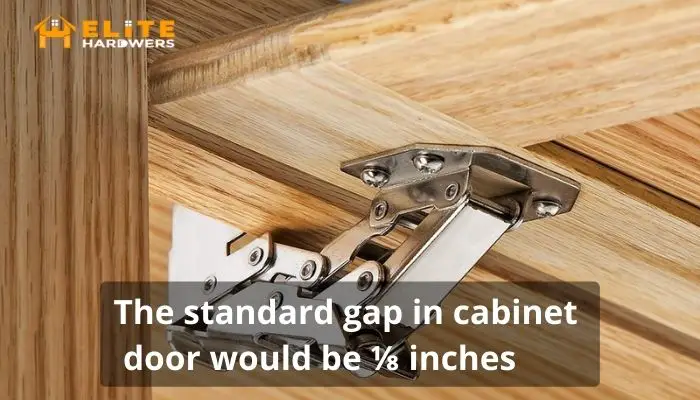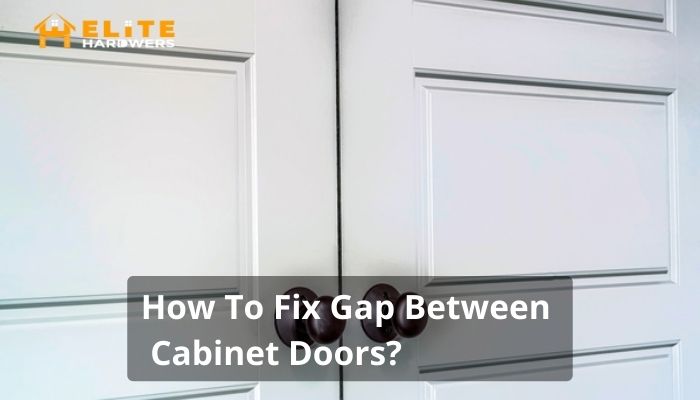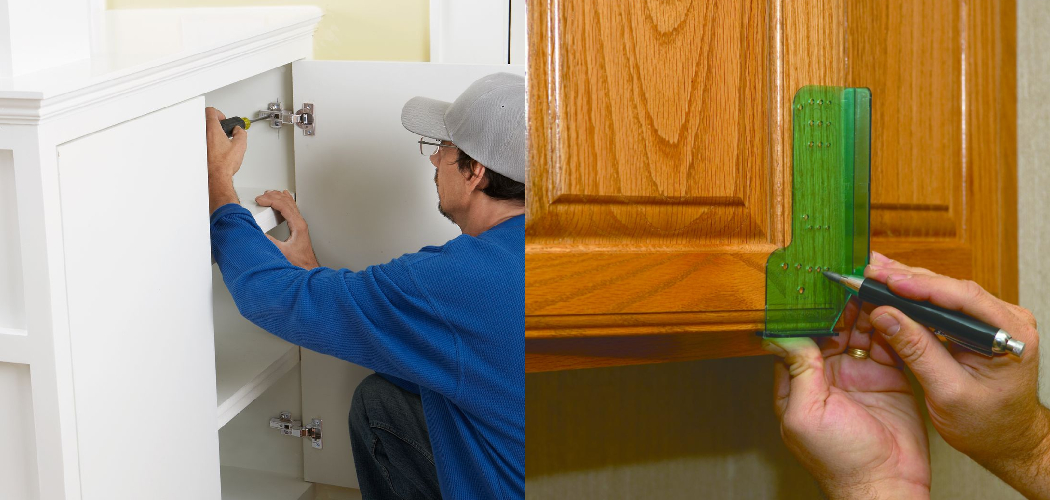Identifying the Cause of the Gap

A gap between cabinet doors can be a common problem, but it can be frustrating to deal with. Before attempting any repairs, it is essential to determine the root cause of the issue. This will ensure you address the problem correctly and prevent it from recurring.
Identifying Common Causes of Gaps, How to fix gap between cabinet doors
Common reasons for gaps between cabinet doors include loose hinges, worn-out hinges, improper door alignment, or cabinet frame issues.
- Loose hinges: Over time, the screws holding the hinges to the cabinet door or frame can loosen, causing the door to sag and create a gap.
- Worn-out hinges: Hinges can wear out, particularly if they are used frequently. This can lead to a gap between the door and the cabinet frame.
- Improper door alignment: If the cabinet door is not properly aligned, it can create a gap. This could be due to the door being installed at an angle or the door being out of plumb.
- Cabinet frame issues: A warped cabinet frame can also lead to gaps between doors. If the frame is not square or level, the doors may not close properly.
- Expansion and contraction of the door: Changes in humidity can cause wooden doors to expand or contract. This can lead to gaps between the door and the cabinet frame.
Checking for Loose Screws
To check for loose screws, simply inspect the hinges on the cabinet door. If any screws are loose, tighten them using a screwdriver. Make sure to use a screwdriver that is the correct size for the screws to avoid damaging the screw head.
Inspecting Damaged Hinges
If the hinges are worn out, they will need to be replaced. Inspect the hinges for signs of wear and tear, such as bent or broken parts. If you find any damage, replace the hinges with new ones.
Assessing Misaligned Doors
To check for misaligned doors, close the door and look at the gap between the door and the frame. If the gap is uneven, the door is misaligned. You can adjust the alignment of the door by tightening or loosening the screws on the hinges. If the door is still misaligned, you may need to consult a professional.
Examining the Cabinet Frame
To examine the cabinet frame, look for signs of warping or bowing. If the frame is warped, it will need to be repaired or replaced. If the frame is bowed, you may be able to straighten it by applying pressure to the affected area.
Adjusting the Hinges: How To Fix Gap Between Cabinet Doors

If the cabinet doors are loose and the gap is inconsistent, adjusting the hinges can help to tighten the doors and close the gap. This involves using a screwdriver to tighten or loosen the screws that hold the hinges to the cabinet door and the cabinet frame.
Adjusting Hinge Screws
To adjust the hinge screws, you will need a screwdriver that fits the screws on your hinges. The following steps will guide you through the process:
- Locate the screws on the hinges. There are typically three screws on each hinge: one at the top, one in the middle, and one at the bottom.
- Tighten the screws with a screwdriver. If the door is loose, tightening the screws can help to secure it to the cabinet frame. If the door is too tight, loosening the screws can help to create more space.
- Check the door alignment after adjusting the screws. If the door is still not aligned, you may need to adjust the hinge placement.
Using a Level to Ensure Proper Door Alignment
A level can be used to ensure that the cabinet door is properly aligned. To use a level, follow these steps:
- Place the level on the cabinet door. Make sure the level is horizontal and aligned with the door.
- Adjust the screws on the hinges until the level is perfectly level. This will ensure that the door is aligned properly.
Adjusting Hinge Placement
If the screws on the hinges are already tightened and the door is still not aligned, you may need to adjust the hinge placement. To do this, you will need to remove the hinges from the door and the cabinet frame.
- Remove the screws from the hinges. You will need to remove the screws from both the door and the cabinet frame.
- Adjust the hinge placement. Once the hinges are removed, you can adjust their position on the door and the cabinet frame. This can help to close the gap between the doors.
- Reinstall the hinges. Once the hinges are in the desired position, you can reinstall them by screwing them back into the door and the cabinet frame.
Replacing Worn-Out Hinges

Worn-out hinges are a common culprit behind cabinet door gaps. Over time, the metal parts of the hinge can become fatigued, leading to looseness and misalignment. Identifying and replacing worn-out hinges is essential for restoring the proper function and aesthetics of your cabinets.
Identifying Worn-Out Hinges
Inspecting the hinges is the first step in determining if they need replacement. Here’s what to look for:
- Excessive Play: If you can wiggle the door significantly when it’s closed, the hinge is likely worn out.
- Loose Screws: Check if the screws holding the hinge to the door or cabinet are loose or stripped. This can indicate wear and tear on the hinge itself.
- Visible Damage: Look for signs of rust, cracks, or other damage on the hinge’s metal parts. These indicate wear and tear that may have compromised the hinge’s structural integrity.
- Uneven Alignment: If the door doesn’t close flush with the cabinet frame, it could be due to worn-out hinges causing misalignment.
Removing Old Hinges and Installing New Ones
Replacing worn-out hinges is a relatively simple DIY project. Here’s how to do it:
- Remove the Door: Unscrew the hinges from the door and cabinet. You may need to support the door while removing the screws to prevent it from falling.
- Remove the Old Hinges: Once the door is off, carefully remove the old hinges from the cabinet and door.
- Install the New Hinges: Align the new hinges in the same positions as the old ones. Use a screwdriver to secure the hinges to the door and cabinet with the provided screws. Ensure the screws are fully tightened.
- Rehang the Door: Reattach the door to the cabinet by aligning the hinges and securing them with screws. Check that the door closes flush and smoothly.
Types of Hinges
There are various types of hinges available, each with its own advantages and suitability for different cabinet styles:
- Full Overlay Hinges: These hinges are the most common type, where the door covers the entire cabinet face. They offer a clean and modern look.
- Semi-Overlay Hinges: These hinges allow the door to overlap the cabinet face slightly, creating a traditional look.
- Inset Hinges: These hinges are used for inset cabinet doors, where the door sits flush with the cabinet frame. They offer a sleek and minimalist look.
- European Hinges: These hinges are known for their durability and adjustability. They are often used in high-end cabinets.
How to fix gap between cabinet doors – Ugh, cabinet doors with gaps? So not aesthetic! Sometimes, it’s just a matter of adjusting the hinges. But if you’re dealing with a thin cabinet, like the ones you see in thin cabinet with doors designs, you might need to get creative.
Maybe try adding a small shim or even using magnetic catches to keep the doors snug. Whatever you do, just make sure it looks sleek and doesn’t clash with your vibe, ya know?
Ugh, that gap between your cabinet doors is driving you crazy? It’s a common issue, especially with older cabinets. But hey, don’t throw them out just yet! A little DIY love can fix it. If you’re thinking about a fresh start, maybe check out this awesome wooden cabinet for bedroom.
But if you’re sticking with what you have, there are some simple adjustments you can make to close that gap. Just remember, a well-maintained cabinet is a happy cabinet!
